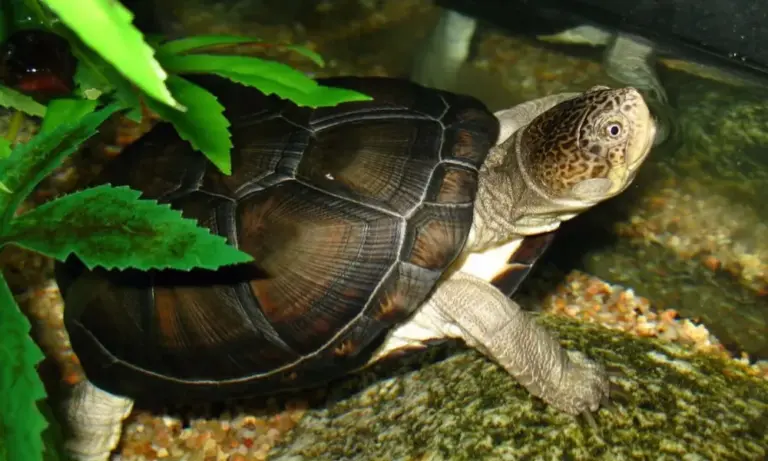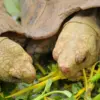The ancient and enigmatic land of Africa, a place of immense charm, boasts abundant resources, profound history and culture, and serves as a sanctuary of captivating landscapes and diverse wildlife.
Turtles in Africa have evolved to embody a uniquely wild character, giving rise to numerous species of African sideneck turtles. These creatures, which thrive in warmth and shun the cold, primarily inhabit tropical regions across Africa. They are widely distributed in freshwater habitats throughout sub-Saharan Africa, Madagascar, and the Seychelles—ranging from dense rainforests to open savannahs.
To survive the harsh conditions of their native environments, some species can even tolerate brackish water. Most are strictly carnivorous, favoring animal-based diets and displaying a strong instinct to hunt live prey. Characterized by their lively, curious, and gentle nature, they rarely show aggression toward humans. When first kept in captivity, they may appear shy; a gentle prodding can send them hiding for hours. However, as they grow accustomed to their caretakers, they develop remarkable interactivity.
Among African sideneck turtle species, the African Helmeted Turtle (Pelomedusa subrufa) and West African Mud Turtle (Pelusios castaneus) are particularly favored by enthusiasts. Due to their relative abundance, these species are common in the pet trade, offering an affordable entry point for hobbyists. These two varieties reign as the most popular choices within the African sideneck turtle family.
Table of Contents
African Helmeted Turtle (Pelomedusa subrufa)
The African Helmeted Turtle is one of the most abundant and widely distributed African sideneck turtle species. Its carapace resembles a cookie-like pattern, and while its appearance may be unremarkable, it boasts exceptional hardiness and adaptability. Thriving in diverse habitats—from rainforests, oases, and grasslands to rivers and lakes—this species has numerous subspecies. Easy to care for, it exhibits a bold, friendly personality and rarely shies away from human interaction. Its expressive eyes and charming demeanor make it a beloved favorite, sustaining its enduring popularity.
West African Mud Turtle (Pelusios castaneus)
The West African Mud Turtle is arguably the most endearing and adorable African sideneck turtle. Widely distributed, it inhabits varied ecosystems ranging from savannahs to forested wetlands, appearing almost ubiquitous. With notable ornamental value, it makes an ideal household pet. Known as the „Husky of the turtle world“ for its goofy demeanor and voracious appetite, this species is endlessly entertaining. Its lively, outgoing nature and excellent interactive behavior captivate owners, earning it a steadfast and fervent fanbase.
Black Forest Sideneck Turtle (Pelusios niger)
The Black Forest Sideneck Turtle is a unique and almost mythical African sideneck species. Despite its unassuming appearance marked by dark, cryptic patterns, it possesses a gentle temperament and an almost spiritual aura. Renowned for its strong bond with caretakers, it often follows its owner to beg for food, showcasing remarkable interactivity.

Adanson’s Sideneck Turtle (Pelusios adansonii)
Adanson’s Sideneck Turtle is a playful and charming African species, its name evoking the grace of a sweet, elegant young woman. While information about this turtle remains scarce, it is celebrated for its exceptional swimming skills. In water, its lively and dynamic movements create an endlessly fascinating spectacle for observers.
Okavango Sideneck Turtle (Pelusios bechuanicus)
Also known as the Bechuanaland Sideneck Turtle, this species captivates with its striking black-and-white, panda-like markings. Its mischievous, boyish personality and playful antics make it endlessly entertaining. Though relatively niche and pricier than common species, its unique charm and rising popularity have begun to draw attention from dedicated enthusiasts.
Central African Sideneck Turtle (Pelusios chapini)
Native to Central Africa, this low-profile species inhabits a broad range yet remains overshadowed by its West African relatives. With minimal ornamental appeal and little fanfare, it often fades into obscurity, rarely acknowledged in the pet trade or conservation discussions.
Keeled Sideneck Turtle (Pelusios carinatus)
Renowned for its exquisite patterning, the Keeled Sideneck Turtle is among Africa’s most visually striking sideneck species. Though relatively abundant in the wild, it is seldom kept in captivity due to its exorbitant cost and limited husbandry data. Its understated elegance and rarity have yet to spark widespread interest among hobbyists.
Kenya Sideneck Turtle (Pelusios broadleyi)
Endemic to Kenya, this species is one of Africa’s most visually stunning sideneck turtles. Its carapace features eye-catching reticulated patterns, exuding a wild, untamed allure. True to its free-spirited nature, it moves with leisurely grace in aquatic environments, embodying an air of relaxed independence.
Yellow-bellied Sideneck Turtle (Pelusios castanoides)
Named for its ivory-hued, golden-yellow plastron, the Yellow-bellied Sideneck Turtle is a lesser-known gem. Its refined, dignified appearance—paired with a gentle yet active temperament—creates a harmonious blend of elegance and vitality. Despite its subdued fame, it remains a subtle standout among African sideneck species.
Dwarf Sideneck Turtle (Pelusios nanus)
True to its name, the Dwarf Sideneck Turtle is the smallest African sideneck species. Petite and delicate in build, it charms with a gentle, docile personality and an understated yet endearing charisma. Universally adored, this tiny turtle wins hearts with its unique blend of cuteness and character.
Ivory Coast Sideneck Turtle (Pelusios cupulatta)
The Ivory Coast Sideneck Turtle boasts a striking, almost regal appearance, marked by a large head and an imposing yet dignified demeanor. Despite its fierce looks, it is surprisingly placid and friendly toward humans. Often mistaken for the Gabon Sideneck Turtle (Pelusios gabonensis), it was later classified as a distinct species. Rarely seen in captivity due to limited availability, this turtle remains obscure in the pet trade, even though wild populations in its native habitat remain relatively stable.
Gabon Sideneck Turtle (Pelusios gabonensis)
particularly Gabon. With piercing eyes and an understated elegance, it exudes quiet grace. Though scarce in captivity, small numbers are bred in managed programs for conservation purposes. Its rarity and specialized care requirements keep it out of mainstream popularity, cherished only by a niche group of dedicated keepers.
Maran’s Sideneck Turtle (Pelusios marani)
Maran’s Sideneck Turtle captivates with its irresistibly cute, almost cartoonish appearance—wide-eyed innocence and a „sweet smile“ make it universally appealing. Despite thriving in the wild, it is virtually absent from the pet trade due to scarce documentation and nearly nonexistent captive-bred availability. This lack of exposure has kept its popularity dormant, leaving it a hidden gem among African sideneck enthusiasts.
Serrated Sideneck Turtle (Pelusios sinuatus)
The Serrated Sideneck Turtle is the largest African sideneck species, with robust wild populations in its native range. Often sharing waterways with crocodiles, it thrives in rivers and lakes. Juveniles are irresistibly adorable, while adults require spacious enclosures due to their size. Though lacking vibrant colors, its streamlined physique and graceful, almost balletic swimming style lend it a quiet elegance. Despite its hardiness and captivating aquatic behavior, it remains underappreciated in captivity, contributing to its modest popularity.
East African Sideneck Turtle (Pelusios subniger)
This unassuming species, widespread across eastern Africa, is often overshadowed by its West African cousin. Leaner in build and less flamboyant, it compensates with subtle charm and a gentle personality. Frequently mislabeled or hybridized with West African Mud Turtles in the pet trade, it holds modest ornamental value but struggles to gain the same recognition.
Rhodesian Sideneck Turtle (Pelusios rhodesianus)
Boasting an exotic name and keen, expressive eyes, the Rhodesian Sideneck Turtle is a hardy and docile species. Despite stable wild populations and no immediate threat of extinction, it remains a rarity in captivity due to scant documentation. Its plain coloration and lack of flashy appeal keep it firmly outside the spotlight, even among dedicated hobbyists.
Williams’ Sideneck Turtle (Pelusios williamsi)
With a muscular build and unassuming appearance, Williams’ Sideneck Turtle is a little-known species. Almost no captive care data exists, and breeding practices remain undocumented. Though abundant in its native habitats, it is neither kept locally as a pet nor exported, ensuring its status as an obscure curiosity.
Madagascar Big-headed Sideneck Turtle (Erymnochelys madagascariensis)
Endemic to Madagascar, this unique sideneck turtle features an imposing, large head and a striking juvenile appearance. Rarely kept due to its high cost and demanding care requirements, it thrives only in tropical conditions—winter hibernation is impossible, necessitating heated environments. While adaptable to commercial turtle diets and blessed with a voracious appetite, it requires expansive aquatic setups with deep water, making it a challenging commitment. These factors limit its appeal to all but the most dedicated keepers.









Add comment